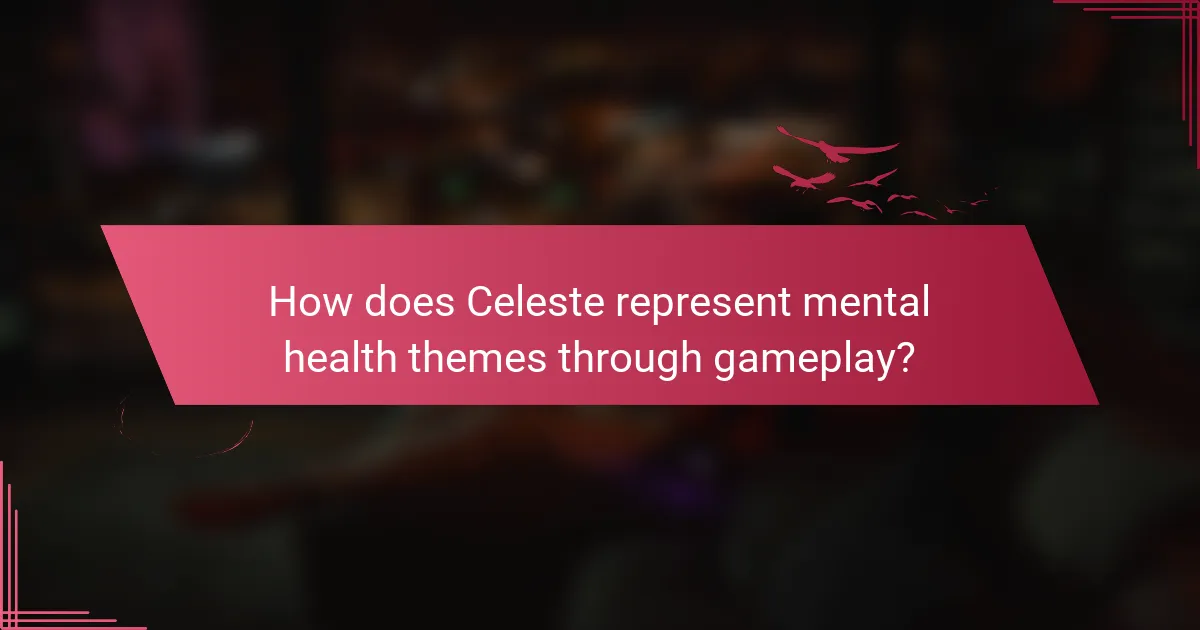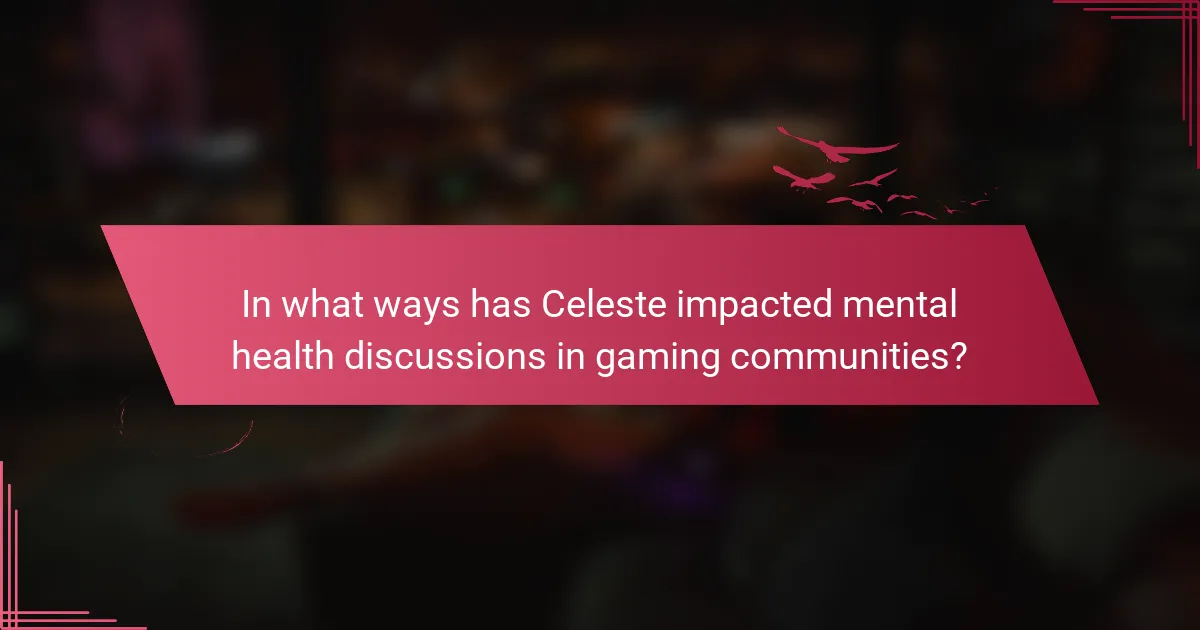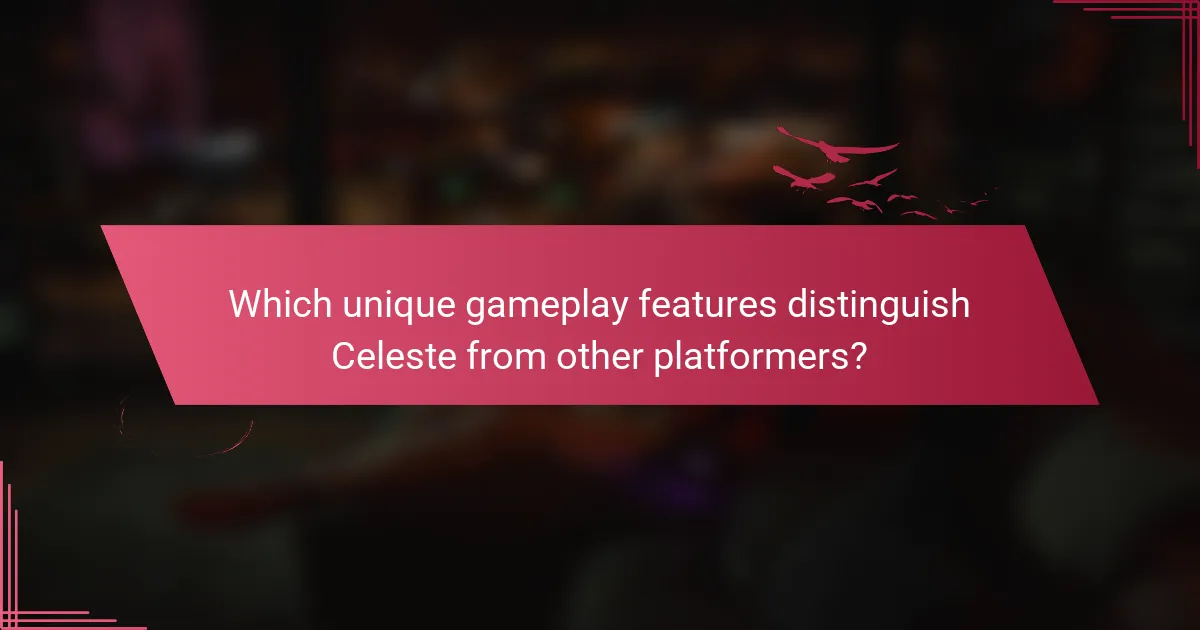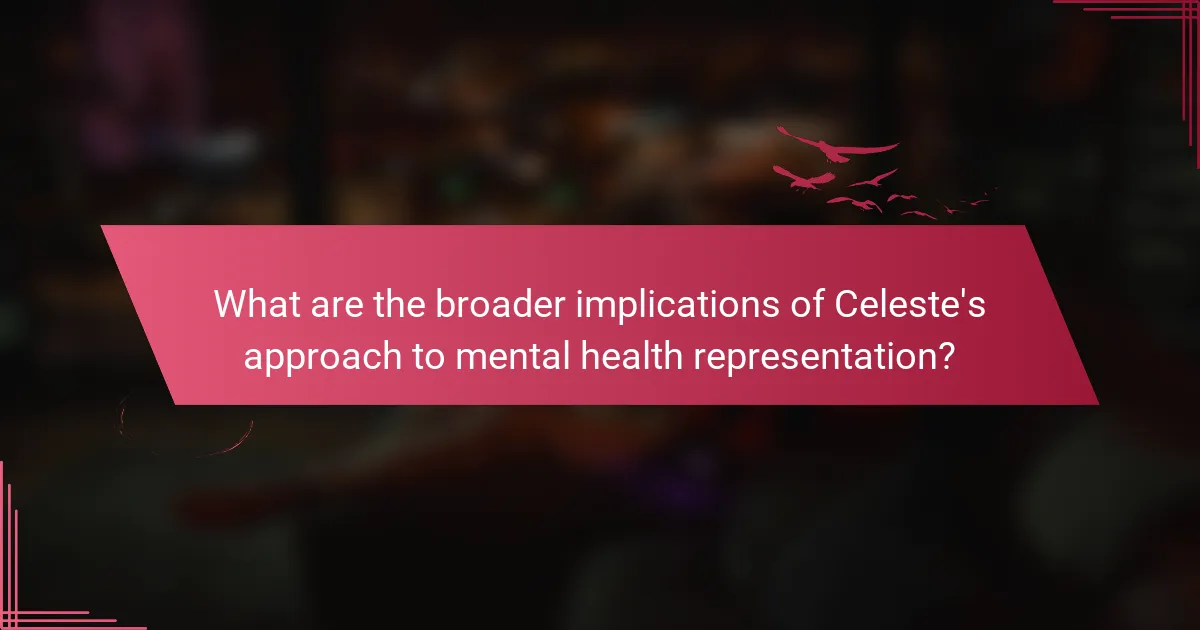Celeste addresses mental health themes through its gameplay and level design, reflecting challenges like anxiety and depression. The game emphasizes accessibility, environmental storytelling, and player agency. Its community fosters open discussions about mental health, creating a supportive environment for players. This approach promotes empathy and understanding, reshaping perceptions of mental health in gaming culture.

How does Celeste represent mental health themes through gameplay?
Celeste represents mental health themes through gameplay by incorporating challenges that reflect emotional struggles. The game’s level design mirrors the protagonist’s internal battles, emphasizing themes of anxiety and depression. Players navigate obstacles that symbolize personal growth and resilience. Additionally, the supportive community fosters discussions around mental health, enhancing the game’s impact.
Which narrative elements address anxiety and depression?
Celeste effectively addresses anxiety and depression through its narrative elements, including character development, environmental storytelling, and gameplay mechanics. The protagonist’s struggles mirror real mental health challenges, fostering empathy. Level design incorporates visual metaphors, representing emotional states and creating immersive experiences. Additionally, community engagement promotes discussions on mental health, enhancing awareness and support.
How do character interactions enhance emotional depth?
Character interactions in “Celeste” significantly enhance emotional depth by fostering connection and empathy. These interactions reveal personal struggles and triumphs, allowing players to relate to the characters’ mental health journeys. For example, the protagonist’s dialogues with other characters often reflect real-life challenges, creating a supportive narrative environment. This unique attribute of character-driven storytelling promotes understanding of mental health issues, making the gameplay experience both engaging and impactful. The game’s level design complements these interactions, as players navigate environments that symbolize emotional states, further deepening the connection to the characters.
What role does symbolism play in the storytelling?
Symbolism plays a crucial role in storytelling by conveying complex themes and emotions. In “Celeste,” symbolism enhances the narrative around mental health, representing struggles through environmental design and character interactions. The mountain symbolizes personal challenges, while the journey reflects the mental health journey itself. This layered symbolism fosters deeper connections within the community, encouraging discussions about mental health and resilience.

What are the key design principles behind Celeste’s level structure?
Celeste’s level structure is designed to reflect mental health themes through challenging gameplay and emotional storytelling. The key principles include accessibility, environmental storytelling, and player agency.
Accessibility ensures that players of all skill levels can engage with the game, promoting inclusivity. Environmental storytelling immerses players in a narrative that resonates with their experiences, enhancing emotional connection. Player agency allows individuals to navigate challenges at their own pace, fostering a sense of control.
These principles work together to create a cohesive experience that not only entertains but also encourages reflection on mental health. Celeste exemplifies how level design can be a powerful tool for representation and community engagement.
How do mechanics reflect the game’s themes?
Mechanics in Celeste symbolize the struggle with mental health through challenging gameplay that mirrors real-life obstacles. Each level’s design reflects emotional states, emphasizing perseverance and growth. For example, the mechanics of climbing and dashing represent overcoming anxiety and self-doubt. The game’s difficulty fosters a sense of achievement, reinforcing the importance of resilience in mental health journeys. Additionally, community engagement around the game encourages discussions about mental health, further amplifying its themes.
What challenges are designed to mirror mental health struggles?
Celeste presents challenges that reflect mental health struggles through gameplay mechanics and narrative design. These challenges simulate feelings of anxiety, depression, and isolation, allowing players to experience and understand these issues. For example, navigating obstacles can mirror real-life difficulties in managing mental health. The game’s design fosters empathy, encouraging community discussions around mental health awareness and support.
How does the level progression support player experience?
Level progression in Celeste enhances player experience by providing a sense of achievement and emotional growth. Each level reflects the protagonist’s mental challenges, encouraging players to confront their own struggles. The gradual increase in difficulty fosters resilience and mastery, promoting a rewarding gameplay loop. As players overcome obstacles, they develop a deeper connection to the narrative, reinforcing themes of perseverance and self-discovery.

In what ways has Celeste impacted mental health discussions in gaming communities?
Celeste has significantly influenced mental health discussions in gaming communities by addressing themes of anxiety and depression through its narrative and gameplay mechanics. The game’s level design mirrors the protagonist’s emotional journey, fostering empathy and understanding among players. Celeste’s community has embraced these themes, creating supportive spaces for sharing personal experiences related to mental health. Additionally, the game encourages open dialogue, making mental health a more prominent topic within gaming culture.
What community initiatives have emerged from the game’s themes?
Community initiatives inspired by Celeste’s themes focus on mental health awareness and support. Players have organized events and forums to discuss mental health, fostering a supportive environment. These initiatives often emphasize sharing personal experiences and coping strategies, promoting community resilience. For example, charity streams and mental health workshops have emerged, directly linking the game’s narrative to real-world advocacy.
How do players share their personal experiences related to Celeste?
Players share personal experiences related to Celeste through forums, social media, and community events. These platforms foster discussions about the game’s mental health themes and level design challenges. Players often highlight how overcoming in-game obstacles mirrors their real-life struggles. Sharing stories builds a supportive community that emphasizes resilience and personal growth.
What role do online platforms play in fostering community support?
Online platforms significantly enhance community support by providing spaces for connection and shared experiences. They facilitate discussions around mental health, allowing individuals to share their stories and resources. Celeste exemplifies this by creating a supportive environment through its level design and narrative, promoting mental health awareness. The game’s community actively engages in discussions, fostering a sense of belonging that enhances overall well-being.

Which unique gameplay features distinguish Celeste from other platformers?
Celeste distinguishes itself from other platformers through its unique gameplay features, such as precise movement mechanics and mental health themes. The game emphasizes a narrative that addresses anxiety and self-acceptance, offering players a relatable experience. Its level design encourages exploration and mastery, with each stage presenting distinct challenges that require skill and patience. Additionally, the game’s community impact fosters support and discussion around mental health, creating a welcoming environment for players.
How does the assist mode cater to varying player needs?
Assist mode in Celeste provides tailored gameplay adjustments to accommodate diverse player needs. It allows for modifications like reduced difficulty and additional checkpoints, enhancing accessibility. This feature promotes inclusivity, ensuring players of varying skill levels can engage meaningfully with the game. By addressing mental health considerations, assist mode supports players facing challenges, fostering a supportive community environment.
What innovations in level design set Celeste apart?
Celeste’s level design innovates through precision in platforming, emotional storytelling, and accessibility features. The game employs mechanics that reflect the protagonist’s mental health journey, enhancing player empathy. Each level intricately balances challenge and reward, fostering a sense of achievement. Unique visual and audio cues guide players, creating a cohesive experience that resonates emotionally.

What are the broader implications of Celeste’s approach to mental health representation?
Celeste’s approach to mental health representation significantly influences community awareness and understanding. By integrating mental health themes into gameplay, it fosters empathy and reduces stigma. This unique attribute enhances player engagement and promotes open discussions about mental health issues. As a result, it creates a supportive environment that encourages players to seek help and share their experiences. The broader implications include a shift in how mental health is perceived in gaming, potentially leading to more inclusive narratives across the industry.
How can other games learn from Celeste’s design and narrative choices?
Other games can learn from Celeste’s design and narrative choices by prioritising mental health representation, creating engaging level designs, and fostering community impact. Celeste effectively addresses themes of anxiety and self-acceptance, resonating with players. Its level design combines challenge with accessibility, allowing players of varying skill levels to progress. Additionally, Celeste’s community engagement through support and discussions around mental health sets a standard for inclusivity and empathy in gaming. These elements create a deeper connection between the game and its audience, encouraging other developers to adopt similar approaches.
What lessons can be applied to enhance mental health awareness in gaming?
Celeste teaches valuable lessons for enhancing mental health awareness in gaming through its narrative, level design, and community engagement. It effectively portrays mental health struggles using gameplay mechanics that reflect emotional challenges.
The game’s design encourages players to confront anxiety and self-doubt, fostering a deeper understanding of mental health issues. Community discussions around Celeste emphasize empathy and support, promoting a positive dialogue about mental health in gaming spaces.
As a result, incorporating relatable narratives and supportive communities can enhance mental health awareness in the gaming industry.
How does Celeste influence the future of game development regarding sensitive topics?
Celeste significantly influences the future of game development by prioritising mental health representation and community engagement. The game uses level design to mirror emotional struggles, creating a relatable experience. This approach encourages developers to address sensitive topics thoughtfully. Celeste’s success demonstrates that games can foster understanding and support for mental health issues, setting a precedent for future projects.
What best practices can developers adopt from Celeste’s community engagement?
Developers can adopt several best practices from Celeste’s community engagement. First, prioritise mental health representation in design, fostering inclusivity. Second, actively solicit feedback from players to enhance gameplay experience. Third, create supportive online spaces for discussion and sharing. Fourth, implement regular updates based on community input to maintain engagement. Lastly, showcase diverse narratives that resonate with different audiences, strengthening community bonds.


